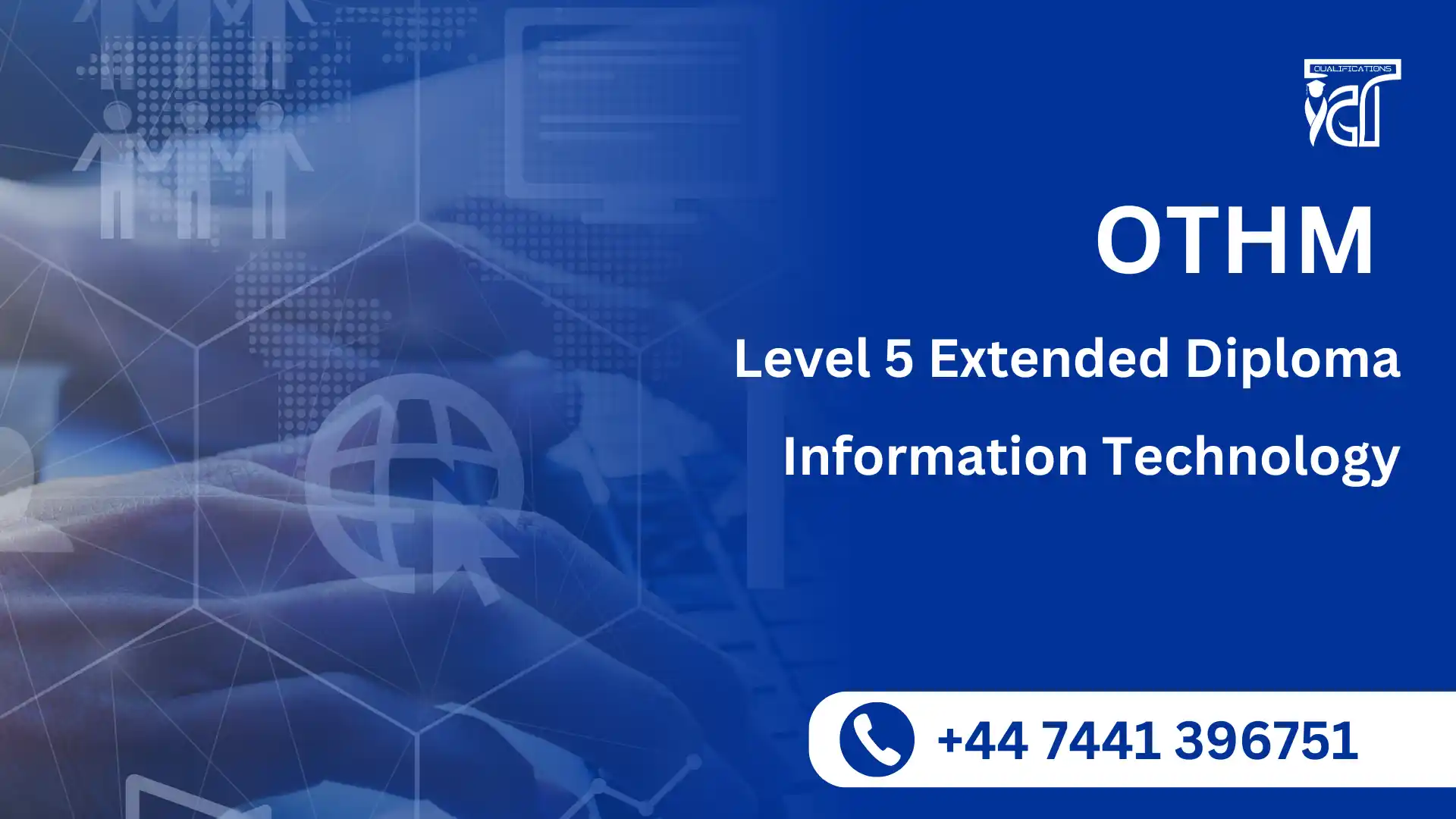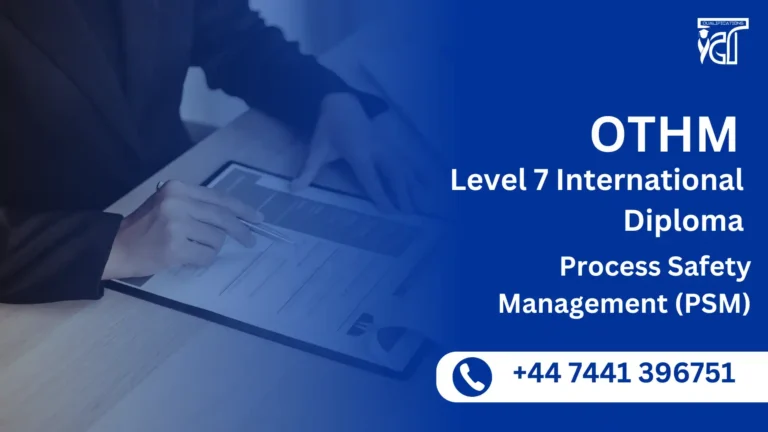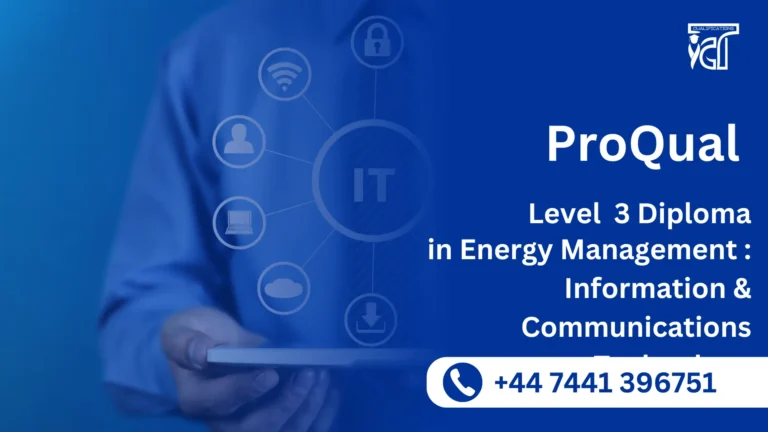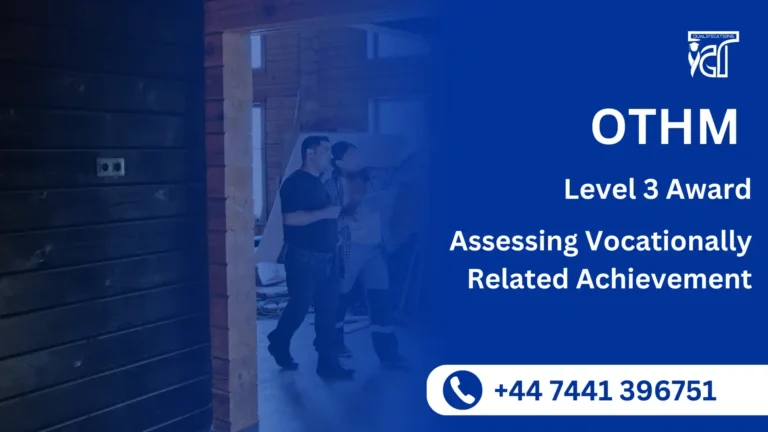In today’s fast-paced digital world, Information Technology (IT) skills are in high demand across all industries. The OTHM Level 4 and Level 5 Combined Diploma in Information Technology is a comprehensive qualification designed to equip learners with the technical knowledge and practical skills required to excel in the IT sector. This combined diploma, regulated by Ofqual, provides a robust foundation for those seeking to advance their IT careers or pursue further academic studies.
The OTHM Level 4 and Level 5 Combined Diploma in Information Technology merges foundational and advanced IT concepts into a single, cohesive program. It offers 240 credits, equivalent to the first two years of a bachelor’s degree, and is fully assignment-based, allowing learners to study flexibly alongside work or other commitments.
This qualification is ideal for individuals aiming to develop expertise in areas such as networking, cybersecurity, software development, and IT management. It is widely recognised by employers and educational institutions worldwide, making it an excellent choice for both career starters and professionals looking to upskill.
The combined diploma provides an in-depth exploration of key IT domains, integrating theoretical understanding with practical application. It is designed to develop both technical competencies and critical thinking skills necessary for problem-solving in IT environments.
The OTHM Level 4 and Level 5 Combined Diploma in Information Technology offers a flexible, comprehensive, and industry-relevant pathway to build a successful career in IT. With a strong academic foundation and practical skills, learners are well-prepared to meet the challenges of today’s digital landscape and drive innovation in their organisations.
Enroll now to advance your IT career with a qualification that combines quality education, practical experience, and global recognition.
OTHM Level 4 and Level 5 Combined Diploma in Information Technology
The OTHM Level 5 Extended Diploma in Information Technology comprises 12 mandatory units (with six units at Level 4 and six units at Level 5), totaling 240 credits, 2400 hours of Total Qualification Time (TQT), and 960 Guided Learning Hours (GLH) for the entire qualification.
Level 4 Mandatory units:
| Sr# | Unit Title | Credits | GLH |
|---|---|---|---|
| 1 | Cyber Security | 20 | 100 |
| 2 | Principles of Computer Programming | 20 | 100 |
| 3 | Systems Analysis and Design | ||
| 4 | Web and Mobile Applications | 20 | 100 |
| 5 | Computer and Network Technology | 20 | 100 |
| 6 | Managing Digital Information | 20 | 100 |
Level 5 Mandatory units:
| Sr# | Unit Title | Credits | GLH |
|---|---|---|---|
| 1 | Software Engineering | 20 | 100 |
| 2 | Database Systems | 20 | 100 |
| 3 | Advanced systems Analysis and Design | 20 | 100 |
| 4 | Management Information Systems | 20 | 100 |
| 5 | Network Information Systems | 20 | 100 |
| 6 | IT Project Management | 20 | 100 |
GLH (Guided Learning Hours) and TQT (Total Qualification Time) are terms commonly used in vocational qualifications to help define the amount of time a learner is expected to spend on heir studies.
1. GLH (Guided Learning Hours)
GLH refers to the number of hours a learner spends being directly taught, supervised, or supported during their course. This includes the time spent in activities such as:
- Classroom instruction
- Practical workshops
- One-on-one tutoring or mentoring sessions
- Online learning sessions with tutor support
In other words, GLH represents the time that learners are actively engaged with their instructors or learning activities.
2. TQT (Total Qualification Time)
TQT represents the total amount of time a learner is expected to invest in completing a qualification, including:
- GLH (Guided Learning Hours): Time spent on direct learning, as explained above.
- Self-Directed Learning: This includes time spent on independent study, research, assignment completion, preparation for exams, and any other work the learner does outside of direct teaching hours.
TQT is a broader measure that includes all the time required to achieve the qualification. It helps learners and employers understand the overall commitment required for the qualification.
Key Differences Between GLH and TQT:
- GLH focuses on direct learning with guidance or supervision.
- TQT includes GLH as well as independent study time and other learning-related activities.
Example:
If a qualification has a TQT of 600 hours and a GLH of 250 hours, it means the learner should spend 250 hours in direct learning (classroom, online, or tutor-led sessions) and 350 hours on independent study or research.
Learning Outcomes of OTHM Level 4 and Level 5 Combined Diploma in Information Technology
Cyber Security
- Understand the fundamentals of cyber security.
- Understand cyber security protection methods.
- Understand how to manage a cyber security attack.
Principles of Computer Programming
- Understand the principles of computer programming.
- Understand the principles of algorithms.
- Understand the object-oriented Programming language.
- Understand the tools and techniques used for software development.
- Be able to create a software programme to solve a problem using object-oriented programming.
Systems Analysis and Design
- Understand the principles of systems analysis and design.
- Understand system design methodologies and modelling.
- Understand human computer interface (HCI).
- Be able to produce a system design using modelling techniques.
Web and Mobile Applications
- Understand web and mobile application design technology.
- Understand website technologies, tools and software used to develop websites
- Understand multimedia content creation tools and software.
- Be able to create a website or mobile application to fulfil a set of client and user requirements.
Computer and Network Technology
- Understand the fundamentals of cloud computing.
- Understand networking principles and their protocols.
- Be able to support and troubleshoot computing problems.
- Be able to demonstrate routing and switching techniques.
Managing Digital Information
- Understand how to assess the digital information needs of an organisation.
- Understand information processes in an organisation.
- Understand compliance and regulations associated with digital information.
- Be able to improve digital information systems for an organisation.
Software Engineering
- Understand modelling languages and their benefits.
- Be able to design and implement a series of UML class diagrams.
- Understand the management of software testing using different strategies.
- Be able to develop a solution using object-oriented programming.
Database Systems
- Understand basic concepts of database systems.
- Be able to design and develop a fully functional relational database system to meet a business need.
- Be able to test database systems and produce required documentation.
Advanced Systems Analysis & Design
- Understand the role of system analysis and design in an organisation.
- Understand the steps needed in system analysis and design.
- Be able to create documented system requirements.
- Be able to develop functional and data models for a software system.
Management Information Systems
- Understand the information system requirements of organisations.
- Understand the use of an information system to produce management information
- Be able to develop and implement a management information system for an organisation.
Network Information Systems
- Understand the principles of networking.
- Understand network management protocols and standards.
- Be able to plan, design, setup and configure a network system.
IT Project Management
- Be able to analyse business objectives to determine potential projects
- Be able to devise a project plan using relevant project management tools and models.
- Be able to manage an IT project.
- Be able to evaluate the project outcomes.
Benefits – OTHM Level 4 and Level 5 Combined Diploma in Information Technology
- Ofqual-Regulated and Internationally Recognised
This qualification meets rigorous UK education standards and is recognised globally by employers and academic institutions. - Equivalent to Two Years of Undergraduate Study
Provides 240 credits, offering a strong academic foundation equivalent to the first two years of a bachelor’s degree. - 100% Assignment-Based Assessment
Enables flexible learning without the pressure of formal exams, ideal for working professionals. - Comprehensive Curriculum
Covers essential IT domains including networking, cybersecurity, software development, and IT project management. - Develops Practical and Managerial Skills
Prepares learners for both technical roles and IT management positions through a balanced skill set. - Enhances Employability and Career Growth
Opens up opportunities for roles such as IT support specialist, network administrator, cybersecurity analyst, and IT project manager. - Flexible Learning Options
Available via online and blended learning, allowing study at your own pace to fit work and personal commitments. - Supports Further Academic Progression
Graduates can progress to Level 6 qualifications, bachelor’s degrees, or professional IT certifications. - Industry-Relevant Knowledge
Keeps learners updated with emerging technologies and best practices essential for today’s dynamic IT environment. - Global Career Opportunities
Recognised worldwide, this diploma equips learners to work in diverse international IT markets.
The OTHM Level 4 and Level 5 Combined Diploma in Information Technology is designed for a wide range of learners aiming to build or advance their careers in the IT sector. This course is ideal for:
- Aspiring IT Professionals
Individuals looking to start a career in information technology with a strong, industry-recognised qualification. - Current IT Practitioners
Those working in IT roles who want to upgrade their skills and gain managerial knowledge to enhance career prospects. - Career Changers
People from other fields seeking to transition into the IT industry and require foundational and advanced IT education. - Students Preferring Flexible Learning
Learners who prefer assignment-based assessments instead of traditional exams, allowing them to balance study with work or personal commitments. - International Learners
Individuals outside the UK who want a reputable, Ofqual-regulated qualification to support global career opportunities. - IT Support, Network, and Cybersecurity Enthusiasts
Those interested in practical IT skills across networking, security, software development, and project management.
This diploma is perfect for anyone committed to developing a comprehensive understanding of IT principles and practices, preparing them for success in a competitive, technology-driven world.
Entry Requirements
Register Now
Qualification Process
Qualification Process OTHM Level 4 and Level 5 Combined Diploma in Information Technology
- Self-Assessment:
Begin by evaluating your eligibility to ensure you meet the qualification requirements, including work experience, knowledge, and language proficiency. - Registration:
Complete your registration by submitting the required documents, including a scanned copy of a valid ID, and paying the registration fee. - Induction:
An assessor will conduct an induction to confirm your eligibility for the course and explain the evidence requirements. If you do not meet the criteria, your registration will be canceled, and the fee will be refunded. - Assignments & Evidence Submission:
Provide all assignments and the necessary evidence based on the assessment criteria outlined in the course. If you are unsure of the required evidence, consult with the assessor for guidance on the type and nature of evidence needed. - Feedback and Revision:
The assessor will review your submitted evidence and provide feedback. Evidence that meets the criteria will be marked as “Criteria Met,” while any gaps will be identified. You will be asked to revise and resubmit if needed. - Competence Evidence:
Submit final evidence demonstrating that all learning outcomes have been met. This evidence will be marked as “Criteria Met” by the assessor once it is satisfactory. - Internal Quality Assurance (IQA):
The Internal Quality Assurance Verifier (IQA) will review your evidence to ensure consistency, quality, and compliance with standards. - External Verification:
The IQA will submit your portfolio to OTHM External Quality Assurance Versifier (EQA) for final confirmation. The EQA may contact you directly to verify the authenticity of your evidence. - Certification:
Upon successful completion of all checks, OTHM will issue your official certificate, confirming that you have attained the OTHM Level 4 and Level 5 Combined Diploma in Information Technology.







